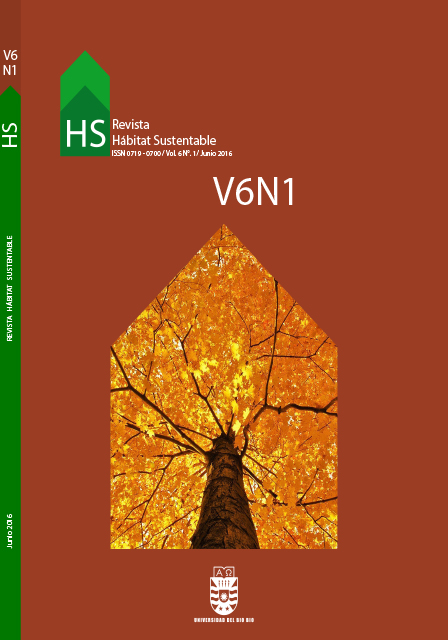Carbon dioxide emissions caused by electric energy consumption in buildings in the Province of San Juan, Argentina
Keywords:
electricity consumption, CO2-equivalent, graphic labelAbstract
Population growth without awareness of energy consumption produces irreversible effects on the environment. Power generation from non-renewable sources is responsible for negative environmental impacts due to the emission of greenhouse gases (GHGs). The concentration of carbon dioxide (CO2) in the atmosphere is a GHG indicator. The CO2 molecule has the ability to store longwave radiation (heat) and avoid the natural heat balance between the Earth and outer space. The aim of this paper is to find a representative value of the CO2 emissions produced by electric energy consumption in the building sector (residential, commercial and public) in the Province of San Juan, Argentina and develop a graphic label to indicate the level of emissions. The analysis takes into consideration international CO2 emissions reference values, energy consumption data and population census data. CO2 emissions per capita are calculated based on local electricity consumption values, categorized by numerical equivalent, and displayed on a graphic label. The CO2-equivalent emissions values obtained are notably low compared to the world average.
Downloads
References
ALAMINO NARANJO, Yesica; KUCHEN, Ernesto; GIL ROSTOL, María Celeste y ALONSO FRANK, Alción. Monitoreo de funcionamiento y estrategias de e ciencia energética para el edi cio público de Obras Sanitarias Sociedad del Estado, San Juan, Argentina. Hábitat Sustentable, 2015, vol. 5, no 1, pp. 14-23,
ALIANO, María Sol, RODRÍGUEZ, Camila y SAGARDOY, Ignacio.
Fortalecimiento de capacidades para contribuir con un desarrollo de bajo carbono y resiliente al cambio climático. UNDP – Secretaría de Ambiente y Desarrollo Sustentable de la Nación. Buenos Aires-San Carlos de Bariloche, 2012.
BERSET, Alberto, TANIDES, Carlos, y GRÜNHUT, Enrique. Etiquetado en e ciencia energética en motores eléctricos industriales y ahorro de energía, 2004.
CÁMARA SÁNCHEZ, Ángeles, FLORES GARCÍA, Mónica y FUENTES SAGUAR, Patricia. Análisis económico y medioambiental del sector eléctrico en España. Estudios de Economía Aplicada, 2011, vol. 29, n°2, pp. 493 – 514.
CARBON DECISIONS. Carbon footprinting: An introduction for organizations [en línea], 2010. [Consultado 8 febrero 2015]. Disponible en: http://www.carbondecisions.ie/resources/footprint_ for_organisations.pdf
DUARTE, Carlos María (coord.). Cambio Global. Impacto de la actividad humana sobre el sistema Tierra. Madrid: CSIC, 2006.
EMPRESA DE SERVICIO DE SUMINISTRO DE LA ELECTRICIDAD EN SAN JUAN (EPSE). Generación de energía eléctrica por recursos [en línea], 2015. [Consultado 12 febrero 2016]. Disponible en: http:// www.energiasanjuan.com.ar/
ENTE PROVINCIAL REGULADOR ELÉCTRICO (EPRE). Consumo energético anual [en línea], 2014. [Consultado 20 enero 2016]. Disponible en: http://www.epresj.gov.ar.
FERRARO, Rosana, GAREIS, María Cecilia y ZULAICA, Laura. Aportes para la estimación de la huella de carbono en los grandes asentamientos urbanos de Argentina. Cuadernos de Geografía. Revista Colombiana de Geografía, 2013, vol. 22, no 2, pp. 87-106.
INSTITUTO NACIONAL DE ESTADÍSTICAS Y CENSOS (INDEC).
Censo nacional de población, hogares y viviendas: Resultados preliminares [en línea], 2010. [Consultado 12 marzo 2016]. Disponible en: http://www. censo2010.indec.gov.ar/
INTERGOVERNMENTAL PANEL ON CLIMATE CHANGE (IPCC).
Cambio climático 2007: Informe de síntesis. Contribución de los Grupos de trabajo I, II y III al Cuarto Informe de evaluación del Grupo Intergubernamental de Expertos sobre el Cambio Climático. Ginebra: IPCC, 2007.
LEY No 1136-J, Decreto No 719-MIyT. Convenio de desarrollo de la Energía Solar Fotovoltaica en la Provincia de San Juan, a través del proyecto tecnológico denominado Polo de Desarrollo Productivo Solar San Juan, 2012.
MINISTERIO DE PLANIFICACIÓN - PRESIDENCIA DE LA NACIÓN [en línea]. [Consultado 3 diciembre 2015]. Disponible en: http://www. energiasanjuan.com.ar.
SECRETARÍA DE ENERGÍA DE LA NACIÓN (SEN) [en línea]. [Consultado 23 enero 2016]. Disponible en http://www.energia.gov. ar
Downloads
Published
How to Cite
Issue
Section
License
The content of articles which are published in each edition of Habitat Sustentable, is the exclusive responsibility of the author(s) and does not necessarily represent the thinking or compromise the opinion of University of the Bio-Bio.
The author(s) conserve their copyright and guarantee to the journal, the right of first publication of their work. This will simultaneously be subject to the Creative Commons Recognition License CC BY-SA, which allows others to share-copy, transform or create new materials from this work for non-commercial purposes, as long as they recognize authorship and the first publication in this journal, and its new creations are under a license with the same terms.











 Scientific Information Program/Concurso Fondos de Publicación de Revistas Científicas 2018/ Proyecto Mejoramiento de Visibilidad de Revistas UBB (Código:FP180007).
Scientific Information Program/Concurso Fondos de Publicación de Revistas Científicas 2018/ Proyecto Mejoramiento de Visibilidad de Revistas UBB (Código:FP180007).





